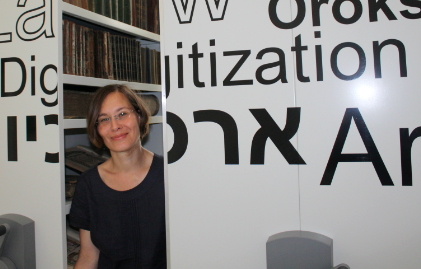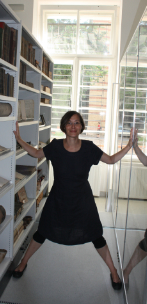Now It Will Be Known What is Behind the Dohány Utca Synagogue!
Rosenthal Lived Here
„In our archival store room-on-display, in our family research center and in our latest exhibition titled Rosenthal lived here, everybody has the chance to see what secrets are kept hidden in the archive.”
| Berényi Marianna |
2011-09-27 08:00 |
 The Jewish communities and archives are looked upon with the same prejudice: they are both regarded secluded and secretive – director of the Hungarian Jewish Archives Zsuzsanna Toronyi states when receiving the editorial staff of Hungarian Museum in the newly renovated building of the community home of the Association of Hungarian Jewish Religious Communities. „In our archival store room-on-display, in our family research center and in our latest exhibition titled Rosenthal lived here, everybody has the chance to see what secrets are kept hidden in the archive.”
The Jewish communities and archives are looked upon with the same prejudice: they are both regarded secluded and secretive – director of the Hungarian Jewish Archives Zsuzsanna Toronyi states when receiving the editorial staff of Hungarian Museum in the newly renovated building of the community home of the Association of Hungarian Jewish Religious Communities. „In our archival store room-on-display, in our family research center and in our latest exhibition titled Rosenthal lived here, everybody has the chance to see what secrets are kept hidden in the archive.”
And indeed, all the elements of the project „The Touristic Development of the Goldmark Hall and Connecting Rooms” serve the aim to free the archive and the Jewish community from the captivity of prejudices and beliefs which still rains over them. Or vice versa, to give more freedom the researchers and visitors they had in the past. The glass windowed, sunny archive, the comfortable research room, the openness of the staff, the easily accessible information and data breaks the inner circle feeling that makes the visitors of archives to become numb among the written relics of the past.
Archival Show Storage – The First One In Central-Europe
 The museum goers may have heard a lot about museum store rooms which can be visited, but store rooms in an archives have been not seen by „laymen”. How can old papers, documents be made interesting to the people of the 21st century? International experience prove the fact that the number of visitors can only be increased when the institutions adapt themselves to their demands and offer something that is not conventional – emphasizes Zsuzsa Toronyi, who had spent quite a lot of time abroad, gathering information and on returning she connected much of the archive into the international digital archival network, into the database of the Europeana.eu The modern handling of documents and exhibiting are important tasks of the institutions of cultural heritage The archival show store room is a place totally new to the public. Along the safe storing facilities documents can be looked at which were only displayed in museum exhibition before, although the impact of authentic sources on the public is well-known among all collection professionals.
The museum goers may have heard a lot about museum store rooms which can be visited, but store rooms in an archives have been not seen by „laymen”. How can old papers, documents be made interesting to the people of the 21st century? International experience prove the fact that the number of visitors can only be increased when the institutions adapt themselves to their demands and offer something that is not conventional – emphasizes Zsuzsa Toronyi, who had spent quite a lot of time abroad, gathering information and on returning she connected much of the archive into the international digital archival network, into the database of the Europeana.eu The modern handling of documents and exhibiting are important tasks of the institutions of cultural heritage The archival show store room is a place totally new to the public. Along the safe storing facilities documents can be looked at which were only displayed in museum exhibition before, although the impact of authentic sources on the public is well-known among all collection professionals.
– Archives are not museums! – states Toronyi Zsuzsa. – Here quantity is just as important as uniqueness. However on the show store room we present the most interesting treasures of the archive. The original autograph of Raoul Wallenberg, beautifully bound parish minute-books, the Dohány utca synagogue meeting records, old parish signets can be seen ont he shelves and cupboards of the archive.
 Past Lost In The Archive
Past Lost In The Archive
"Many times people from abroad came to the archives who had nothing to go on but the memory of some Hungarian ancestry. That is one of the reasons we thought it important to create a center, where visitors can find all the questions to their answers concerning the remains of the history of their families" - says Toronyi.
Where Did Actually Live Rosenthal?
The question is not only raised in the research room, it was given a special space in the alcove of the Goldmark Hall. The answer differs naturally: „The home of the Rosenthals was to be found int he settlement of Moór, a few kilometers from here” „The Rosenthals lived in Szombathely in the 1920s”…
– „You can find a Rosenthal in each era” – smiles Zsuzsa Toronyi. − „The context of the exhibition Rosenthal lived here is provided by the family history research center, by the show store room, and by the close vicinity of the building, the former Jewish quarter. The mosaics of the Jewish life experience are put together with the help of all the objects kept from 20 families, maps from 10 different ages and by many other treasures from the Hungarian Jewish everyday life.